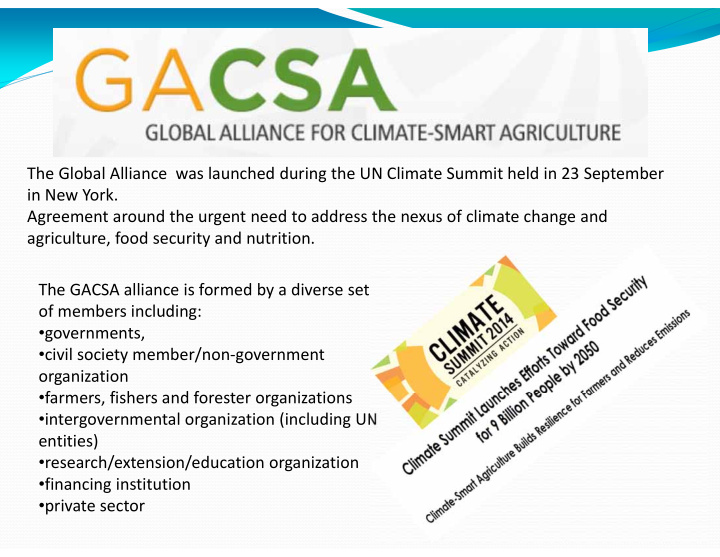



The Global Alliance was launched during the UN Climate Summit held in 23 September in New York. Agreement around the urgent need to address the nexus of climate change and agriculture, food security and nutrition. The GACSA alliance is formed by a diverse set of members including: • governments, • civil society member/non ‐ government organization • farmers, fishers and forester organizations • intergovernmental organization (including UN entities) • research/extension/education organization • financing institution • private sector
OBJECTIVES
How CAgM Was liasing: in partnership Uruguay Govt in Punta del Est. 658 participants from 101 Countries, over 1000 people on ‐ line, representatives of a wide range of organizations involved, across the spectrum from farmers to upstream research .
Climate-Smart Agriculture Alliance meeting, January.2014, Cuba Room, FAO Headquarters «GFAR will continue to welcome WMO CAgM inputs as well as your personal ones in this process. We do hope that our collaboration will help in creating a solid strategic and operational alliance on Climate Smart Agriculture and look forward to continuing this partnership with CAgM WMO.»
Which in common : • Network and capacity building in matching food security; support a new climate ‐ resilient agriculture, able to adapt, mitigate when feasible, make the better use of resources, being weather /climate information the primary drivers. • Recovering of tools/technologies scientifically sound, test them, translate into operational tools for end ‐ users Which indicators: • Come up with the definition on how to measure vulnerability, mitigation. • Boost the adoption of climate ‐ weather based information. • Increase cooperation between agronomists / climatologists/ meteorologist, with agrometeorologist as the main experts. • Extension, NMHSs services able to address farmers with climate data at their scale of decision. Support decision making in strategic and tactical approach to adaptation. • Appropriate networking for all the regions. • Communicate properly at each level: age, gender, instruction, culture, geographical context) and provide instruments for this: Empower the dialogue agromet/met/climate people and agricultural actors.
Recommend
More recommend